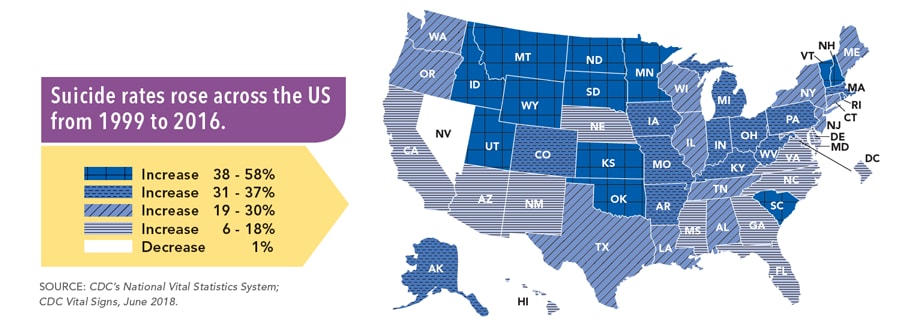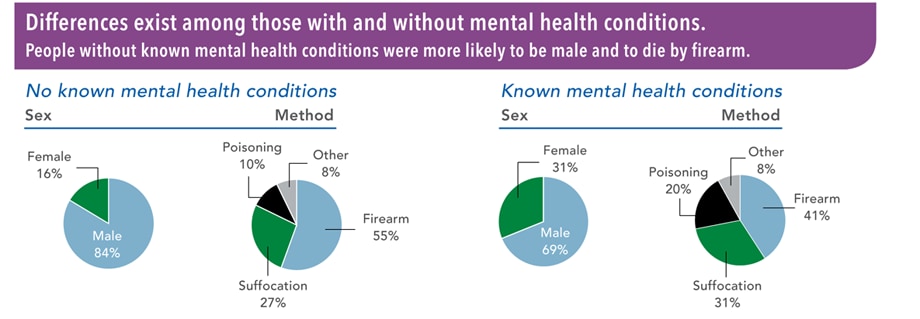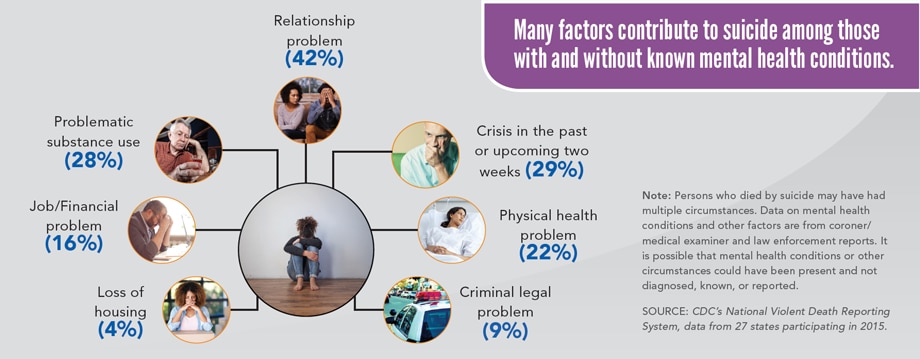Get Email Updates
To receive email updates about this page, enter your email address:
Related Links
Suicide rising across the US
More than a mental health concern
45K. Nearly 45,000 lives lost to suicide in 2016 .
30%. Suicide rates went up more than 30% in half of states since 1999.
54%. More than half of people who died by suicide did not have a known mental health condition.
Overview
Suicide is a leading cause of death in the US. Suicide rates increased in nearly every state from 1999 through 2016. Mental health conditions are often seen as the cause of suicide, but suicide is rarely caused by any single factor. In fact, many people who die by suicide are not known to have a diagnosed mental health condition at the time of death. Other problems often contribute to suicide, such as those related to relationships, substance use, physical health, and job, money, legal, or housing stress. Making sure government, public health, healthcare, employers, education, the media and community organizations are working together is important for preventing suicide. Public health departments can bring together these partners to focus on comprehensive state and community efforts with the greatest likelihood of preventing suicide.
States and communities can:
- Identify and support people at risk of suicide.
- Teach coping and problem-solving skills to help people manage challenges with their relationships, jobs, health, or other concerns.
- Promote safe and supportive environments. This includes safely storing medications and firearms to reduce access among people at risk.
- Offer activities that bring people together so they feel connected and not alone.
- Connect people at risk to effective and coordinated mental and physical healthcare.
- Expand options for temporary help for those struggling to make ends meet.
- Prevent future risk of suicide among those who have lost a loved one to suicide.

WHAT CAN WE DO TO PREVENT SUICIDE?
Preventing Suicide: A Technical Package of Policy, Programs, and Practices,https://go.usa.gov/xQBGc
Preventing suicide involves everyone in the community.
Provide financial support to individuals in need.
- States can help ease unemployment and housing stress by providing temporary support.
Strengthen access to and delivery of care.
- Healthcare systems can offer treatment options by phone or online where services are not widely available.
Create protective environments.
- Employers can apply policies that create a healthy environment and reduce stigma about seeking help.
Connect people within their communities.
- Communities can offer programs and events to increase a sense of belonging among residents.
Teach coping and problem-solving skills.
- Schools can teach students skills to manage challenges like relationship and school problems.
Prevent future risk.
- Media can describe helping resources and avoid headlines or details that increase risk.
Identify and support people at risk.
- Everyone can learn the signs of suicide, how to respond, and where to access help.
Know the 12 Suicide WARNING SIGNS
- Feeling like a burden
- Being isolated
- Increased anxiety
- Feeling trapped or in unbearable pain
- Increased substance use
- Looking for a way to access lethal means
- Increased anger or rage
- Extreme mood swings
- Expressing hopelessness
- Sleeping too little or too much
- Talking or posting about wanting to die
- Making plans for suicide
5 Steps to help someone at risk
- Ask.
- Keep them safe.
- Be there.
- Help them connect.
- Follow up.
Find out how this can save a life by visiting: www.BeThe1To.com
What Can Be Done
The Federal government is
- Tracking the problem to describe trends, circumstances, and populations at greatest risk (for example, see www.cdc.gov/violenceprevention/nvdrs).
- Developing, implementing, and evaluating suicide prevention strategies.
- Working with local, state, tribal, national, and other partners to provide guidance and distribute suicide prevention tools (for example, see https://go.usa.gov/xQBGc).
States and communities can
- Identify and support people at risk of suicide.
- Teach coping and problem-solving skills to help people manage challenges with relationships, jobs, health, or other concerns.
- Promote safe and supportive environments. This includes safely storing medications and firearms to reduce access among people at risk.
- Offer activities that bring people together so they feel connected and not alone.
- Connect people at risk to effective and coordinated mental and physical healthcare.
- Expand options for temporary assistance for those struggling to make ends meet.
- Prevent future risk of suicide among those who have lost a loved one to suicide.
Health care systems can
- Provide high quality, ongoing care focused on patient safety and suicide prevention.
- Make sure affordable and effective mental and physical healthcare is available where people live.
- Train providers in adopting proven treatments for patients at risk of suicide.
Employers can
- Promote employee health and well-being, support employees at risk, and have plans in place to respond to people showing warning signs.
- Encourage employees to seek help, and provide referrals to mental health, substance use disorder, legal, or financial counseling services as needed.
Everyone can
- Ask someone you are worried about if they’re thinking about suicide.
- Keep them safe. Reduce access to lethal means for those at risk.
- Be there with them. Listen to what they need.
- Help them connect with ongoing support like the Lifeline (1-800-273-8255).
- Follow up to see how they’re doing.
- Find out how this can save a life by visiting: www.bethe1to.com.
The media can avoid increasing suicide risk (e.g., by not using dramatic headlines or providing explicit details) and encourage people to seek help.
View recommendations at: www.ReportingOnSuicide.org
If you need help for yourself or someone else, please contact the
National Suicide Prevention Lifeline
Talk: 1-800-273-TALK (8255)
Issue Details
Related Pages
- Vital Signs Issue Details: Vital signs Issue details: Trends in State Suicide Rates — United States, 1999–2016 and Circumstances Contributing to Suicide — 27 States, 2015 Morbidity and Mortality Weekly Report (MMWR)
- Preventing Suicide: A Technical Package of Policy, Programs, and Practices
- National Vital Statistics System
- National Violent Death Reporting System
- Web-based Injury Statistics Query and Reporting System (WISQARS)
- CDC’s Division of Violence Prevention
- Suicide in Rural America
CDC Suicide prevention:
- Public Health Grand Rounds: Preventing Suicide: A Comprehensive Public Health Approach
- Suicide Prevention web site
- Uniform Definitions for Self-Directed Violence
- Preventing Suicide Fact Sheet
- Data sources
- Connecting the dots: Exploring the overlaps between multiple forms of violence
Other Sites
- Suicide Prevention Resource Center
- National Action Alliance for Suicide Prevention
- National Strategy for Suicide Prevention
- Recommendations for Reporting on Suicide
- National Suicide Prevention Lifeline
- #BeThe1to campaign
- Project 2025
- Medline Plus–Suicide






No comments:
Post a Comment
Thanks for commenting. Your comments are needed for helping to improve the discussion.